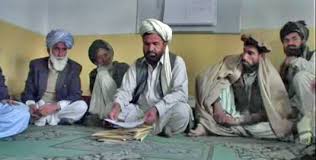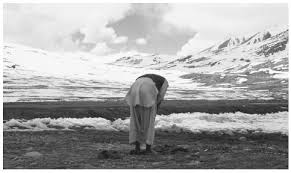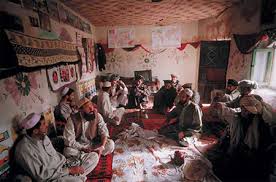|
Buner is the home of the descendants of the Yousafzai
tribe of Pakhtoons and other ethnic groups such as Sayeds, Gujars, Ajars as well as some non-Muslims groups
such as Siks and Hindus. The people of Buner are known as Bunerwal after the name of their home land Buner. The basic values
of the people of Buner are similar to other Pakhtoons, but certain traits are unique to the area.
|
| |
- Language:
The main language spoken in Buner is Pukhto. Some
non-Pakhtoons speak in their native tongue while others speak Pukhto in their daily lives. Example is that “Ajars” and “Gujars” also speak Ajari and Gujari languages respectively. The
influence of other languages like Urdu and English is rare, but unlike the uneducated pakhtoons of the past, the educated
class of the society is constantly replacing the original Pukhto words with the Urdu or English couterparts. Hence words are
disappearing from the spoken language which may result over time in the disappearance of the original language.
|
- Dress:

"Kamees-Partoog-Waskat-Pakol-Panjadari
Saplai/Bandi Saplai" is the traditional style of a Bunerwal man. In the past, the traditional man wore "Patkai"(turban),
however it is now reserved for religious clerics. Women wear "Kamees-Partoog-Loopata" of various different
styles and little girls on the other hand wear "Cholai" which is a round dress . Golden jewellry is very common
in Buner as is across many Pakthoon areas which women love to wear on different occasions.The Buner women wear Bolqa/Paroney
(Buqra and Vail) when they are in public.
- Occupation:

The people of Buner are
mostly farmers and live on what they get from their fields and farms. Due to education, there have been huge advances in the
type of profession of Bunerwals. A large number of the educated class is employed by the government. Another segment
of the younger generation is employed abroad in countries like Malaysia, UAE, Saudi Arab, Qatar, Bronei, Kuwait, Bahrain,
USA, Uk, Japan, Hong Kong etc.
- Life
Style:

Life style of an ordinary
Bunerwal is simple.
As the author of the Love
Toknow 1911 Encyclopedia states about Bunerwal "Simple and austere in their habits, religious truthful in their ways,
hospitable to all who seek shelter amongst them, free from secret assassinations, powerful and warlike tribe, they are bright example
of the Pathan character at its best."
Family system is the back bone of the society. Each member of the family supports the other. If one is taking
care of the family, the other is abroad to earn money for a better life. Father or Grandfather is the "King" who
controls the whole family and Mother or Grandmother is the "Queen" of the family. Similar to other Pakhtoons, a
Bunerwal house is also like a small kingdom. Every one knows has a place and a duty to perform. At the end of
the day, they sit down around one "Dastarkhuan" or table to have dinner together and drink tea. They end the
day with topics such as discussing problems that they may have encountered, taking new steps for new plans and attending other
occasions. The younger folks sit together and tell each other stories and jokes through the night in what is referred
to as Hujra or Dera, which is a guest room specifically reserved for men outside the house.
- Food:

Bunerwal like meat dishes,
'fried fish, 'vegetables, 'different kinds of 'Dals,' 'Kari, ' Saag' lawan, 'Chapli Kabab,
' Choli, 'Kolat, 'Polaw, 'Tekki, 'Shomley, 'Masta, 'Kowach, 'etc. Corn bread, wheat
bread and rice, are always the main components of each meal. Breads are usually baked in "Tanoor" and on Tabakhey/Tabai.
Tanoor Corn bread goes well with "Shomley'/ ' Masta' + 'Chakni' and 'Saag"
"Pikawri"
is also very delicious and good at snack time which goes well with "Choley".
Milk tea is common and tea without
milk is always considered as the sign of poverty. Milk tea goes well with "Paratey" usually taken at breakfast.
It also goes well with "Pikawri". Bunerwals take tea at three times, morning, afternoon and after dinner.
"Matyayi, 'Ghunzakhi, Halwa, 'Kakori, 'Masaldara Gora, 'Ladoo, and 'Gulabjaman" are amongst
the Bunerwals favorite sweets.
- Religion:

Islam is the religion of the people of Buner. Sikhs and Hindus are minorities who are very few in the area.
There
are many Masques in the valley which are usually full of "MonzGuzar" people. The people attending the Mosques usually
discuss various issues related to society and politics after the prayers "Moonz". "Jumat(Mosque)" also
play a major role in the improvement of the society. "Darmasal" and "Gordwara" serve the needs of the
non-Muslim minorities.
- Customs:

Pakhtoon customs are similar
across the Pakhtoon tribes. They support each other in difficult times and participate in each other's ceremonies
which is an integral part of the Buner culture. It is very important to attend wedding parties if invited and compulsory
to attend funeral ceremanies, otherwise that person would not be welcomed in the society. During wedding "Janj"
a group of people from the groom's house go to the Bride's house to bring the "Dolai" to the
groom's house in a very festive an joyful celebration.
- Festivals:

The people of Buner
Valley oberve Eid Ul Fitar and Eid Ul Adha with great joy. Children always look forward to receiving special Eid money from
their elders, so that they could enjoy the "Akhtar Melae" (a large gathering of people that celebrate Eid with various
entertaiment options for all) with their friends. They usually go to Pir BaBa and Qaadar Nagar, Buner's tourist
spots.
- DEATHS: The
death is mourned for three days at least usually in the common Hujras by all the people of the village.
- SPORTS: Football,
Cricket, waliball and Mukha are most common games. Other small games like Bilawrai, Mardaki, Skhey, Gotai, Mirgati(Salgati),
Gopai, Tindak, Shatopai , Patpatawooney and many more have kept our culture alive and enriched over the years of our history.
If you want to comment on the cultural background of Buner Valley, please
send your comments to us. We will gladly review them and if it meet the standard of buner.com we will publish them under the original author's
name.
Our goal is to educate the public and encourage you to take active part in a positive manner. Your support
is critical. Together we can all make a difference.